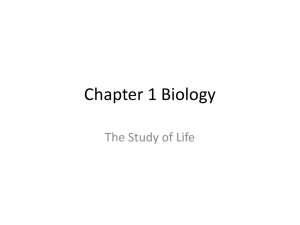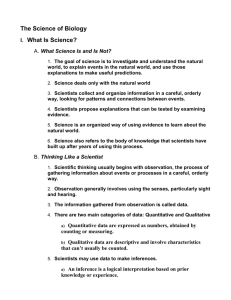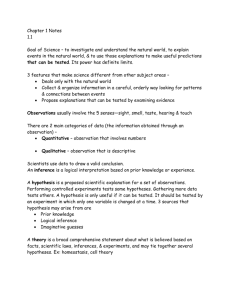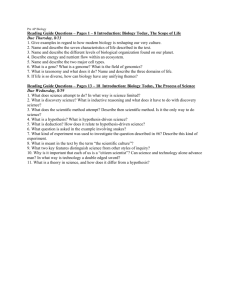Chapter 1 The Science of Biology
advertisement
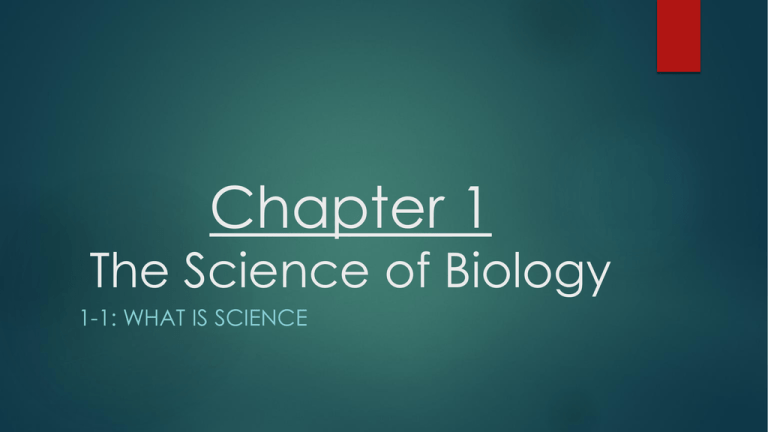
Chapter 1 The Science of Biology 1-1: WHAT IS SCIENCE What science is and is not… KeyC#1: The goal of science is to investigate and understand the natural world, to explain events in the natural world, and to use those explanations to make useful predictions Three features of science: 1. In the context of the natural world 2. Data collection is organized (look for patterns/connections) Investigate Explain 3. Must be testable by looking at evidence Make predictions Def: Science—an organized way of using evidence to learn about the natural world. Thinking like a scientist Scientific thinking: Def: Observation—use of senses to gather information (data) in an orderly fashion Data: Quantitative—expresses as numbers (counting/measuring) Qualitative—descriptive characteristics (cannot be counted) What are some examples of quantitative vs. qualitative? Scientists use data to make inferences. Def: Inference—logical interpretation based on prior knowledge or experience (ex. water in reservoir) Explaining and Interpreting Evidence After initial observations of the natural world, researches will propose a Def: Hypothesis—proposed scientific explanation for a set of observations Hypotheses rise from: Prior knowledge Logical inference Informed, creative imagination Must be testable. Can be ruled out or supported/confirmed. Science as a way of knowing The best scientists are skeptics Don’t be afraid to ask questions. Questions both existing and new hypotheses. There are limits to science and definite lines that should not be crossed. What do you think determines where these lines are drawn? First question in the bible: Genesis 3:1 “Now the serpent was more crafty than any of the wild animals the LORD God had made. He said to the woman, ‘Did God really say, ‘You must not eat from any tree in the garden’?’” Writing assignment: Where is the line? Write a paragraph (5 complete Edward Jenner video sentences, TS, 3 SS, CS) explaining why Jenner’s research methods might have been controversial and whether you support/challenge his methods. Chapter 1 The Science of Biology 1-2: HOW SCIENTISTS WORK Designing an experiment First: Ask a question. (i.e. how did maggots get on the meat? Spontaneous generation?) Def: Spontaneous generation: life from non-living matter Variables: factors that can change (i.e. equipment used, materials, temperature, light, time) KeyC#1: Whenever possible, a hypothesis should be tested by an experiment in which only one variable is changed at a time. All other variables should be kept unchanged, or controlled. Controlled experiment: Second: Form a hypothesis. (i.e. maybe maggots come from flies) Setting up a controlled experiment Remember: observe and propose an explanation Manipulated variable: changed by the researcher Responding variable: changes in response to the manipulated variable Let’s look at Figure 1.8 (Pg. 9) Designing an experiment cont’d… Recording & Analyzing Results: Repeating experiments: Always keep a record of your data (hard copy/digital) Your work is a contribution to the science community What types of data can we observe? Let’s look at Figure 1-11, pg. 12 How did Pasteur’s test add to Redi’s experiment? What was his conclusion? Drawing a conclusion: Data is used to refute for support the hypothesis. Remember: have integrity! Do not manipulate your data! When experiments are not possible Other ways of testing a hypothesis: Field studies Clinical studies (i.e. cancercausing chemical) How a theory develops: Well supported hypothesis can become a theory Def: Theory—well tested explanation that unifies a broad range of observations Remember: a theory cannot be considered as absolute truth. Why? Chapter 1 The Science of Biology 1-3: STUDYING LIFE Characteristics of living things Def: Biology—The science that employs the scientific method to study living things KeyC#1: Living things share the following characteristics… 1. Made up of units called cells 2. Reproduce 3. Based on a universal genetic code 4. Grow and develop 5. Obtains and use materials and energy 6. Respond to their environment 7. Maintain a stable internal environment 8. Change over time Big Ideas in Biology: Timeline of our learning… Science as a way of knowing Interdependence in nature Matter and energy Cellular basis of life Information and Heredity Unity and diversity of life Evolution Structure and Function Homeostasis Science, Technology, and Society What idea are you most excited about learning? Branches of Biology KeyC#2: Some of the levels at which life can be studied include: Molecules Cells Groups of cells Organisms Populations Communities Ecosystems Biosphere Complete your flowchart! Hole punch and keep in your handouts divider! Biology is a part of your every day life! (p. 22) Chapter 1 The Science of Biology 1-4: TOOLS AND PROCEDURES A Common Measurement System KeyC#1: Most scientists use the metric system when collecting data and performing experiments. Metric System Decimal system Based on physical standards Scaled on multiples of 10 Let’s look at figure 1-21 (p. 24) How do scientists collect data?? What is the purpose of a graph or table? Microscopes Microscopes—devices that produce magnified images of structures that are too small to see with the unaided eye KeyC#1: Light microscopes produce magnified images by focusing visible light rays. Electron microscopes produce magnified images by focusing beams of electrons. Read Appendix D! Light Microscopes: View living things 1000x magnified Electron Microscopes: View smaller non-living or dead samples with more detail than light micro. TEM: inside of cells SEM: surface of cells Laboratory Techniques Cell culturing: growing a single cell into many cells (cell culture) Cell fractionation: separate cell parts (blend & centrifuge)

